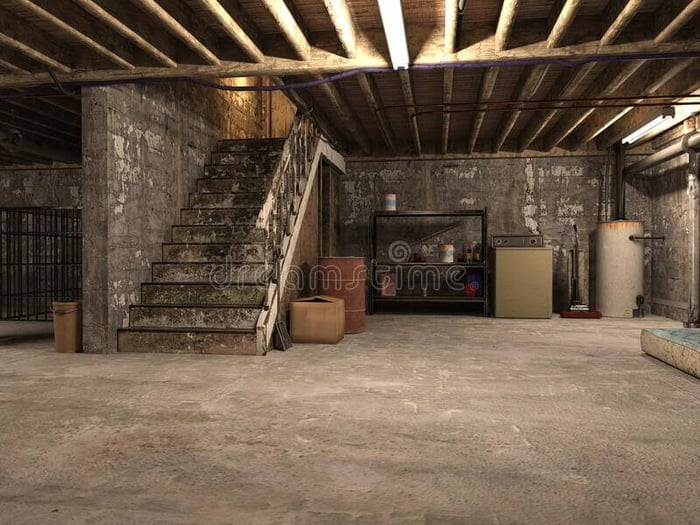Today let's talk about what to do if you discover your water heater has been damaged by a broken water heater flood or external floodwater, why immediate replacement is usually necessary for safety, and—most importantly—how to protect your home from future flood damage using solutions like flood barriers and flood doors.
Statistically, a significant number of American households experience some level of water damage due to flooding. Floods are indeed happening more often today due to climate change and numerous other factors. While not all are as destructive and epic as some well-publicized regional floods, every instance of flooding, even a seemingly moderate one, can cause you a great deal of trouble.
Basement flooding is a common occurrence, and it means that the equipment and appliances you store there are most likely to be damaged. For example, if your water heater is located in your flooded basement, there is a strong chance it got submerged.
⚠️ A Flooded Water Heater: Why Replacement is Essential
Finding your water heater submerged after a flood can be a jarring and expensive revelation. While the temptation is to simply dry it out and try to restart it to cut costs, experts overwhelmingly advise against this. When dealing with a broken water heater flood, safety must be your absolute first priority.
What the Experts Say
According to the Air Conditioning, Heating, and Refrigeration Institute (AHRI), once an appliance like a refrigerator, air conditioning unit, or a water heater has been flooded, you should stop using it immediately! The danger is significant, even if the appliance appears to be refurbished or dried out. AHRI experts insist that it is dangerous to use any such appliance after water damage, recommending replacement for your own safety.
The Hidden Dangers of Water Damage
Every homeowner wants to cut costs, leading many to search for "mitigating circumstances" to avoid replacing a flood-damaged water heater. They might rationalize that the flooded basement wasn't "that" bad, or the unit is gas-fired, not electric. They may note that visually, everything looks fine, with no immediate signs of corrosion or dirt.
However, water damage is not always visible or instantly apparent. Floodwater can recede quickly, making it difficult to evaluate the actual flooding level and its extent inside the unit. Even if your water heater is a gas model, moisture can damage crucial control valves and burner assemblies. For electric water heaters, the risks of electrical shorts, fire, and electrocution are extreme.
🛡️ Critical Steps After a Broken Water Heater Flood
If you discover your water heater has been affected by a broken water heater flood or external basement flooding, follow these essential steps to ensure safety and minimize further damage:
Turn Off Power and Gas Immediately: Before you enter the area, if the unit is electric, shut off the power at the main circuit breaker. If it is gas-fired, shut off the gas supply line to the unit. Do not attempt to operate or test the unit while it is wet or while standing in water. Water and electricity are a deadly combination.
Replace, Do Not Repair: You have to replace a water heater if ANY part of the appliance—especially the controls, insulation, or burner assembly—got flooded.
Gas-Fired Water Heaters: Floodwater can quickly corrode the delicate control valves, burner assemblies, and thermostats. These components are vital for safe operation. Even if the unit appears to work, hidden damage can lead to gas leaks or improper venting.
Electric Water Heaters: The insulation, heating elements, and electronic controls of an electric unit are highly susceptible to permanent, dangerous damage from floodwater. Using it is unsafe.
Check Insulation: Even if the main components didn't seem fully submerged, water can damage the tank's internal insulation. Once compromised, this insulation can harbor dirt, bacteria, and mildew, contaminating the water heated for your household.
Professional Replacement is Mandatory: Replacement of a flooded water heater is not a DIY project. You should hire a qualified, licensed professional contractor for the job to ensure safe installation, proper venting, and correct gas and electrical connections.
Additional Components: Along with the water heater itself, you may need to replace the Temperature and Pressure Relief (T&P) valve, which is crucial for preventing dangerous pressure buildup.
The unfortunate truth is that replacement of a flood-damaged water heater is almost always inevitable. While it takes time, money, and effort, your safety and the long-term integrity of your home's water quality depend on it. A defective water heater won't just spoil the quality of water in your house, but may lead to dangerous and destructive consequences like fire, gas leaks, or future floods.
🔒 Prevention is Key: Stopping Basement Flooding Before It Starts
Once the water heater gets flooded, the outcome is clear: you will have to replace it. The only way to truly save money, time, and effort is to prevent the flooding in the first place. This is especially important for homes in flood-prone areas or those facing coastal floods or sudden downpours.
Basement flooding is notoriously hard to protect against because basement passages, windows, and vents are below ground level. Standard doors are often not enough to stop rising water.
Utilizing Flood Barriers and Flood Doors
Investing in high-quality flood protection is the smartest defense against a broken water heater flood.
Temporary Flood Barriers: These are a wonderful, versatile solution for protecting vulnerable basement entries, window wells, and doorways. They are straightforward to install and remove, can be stored compactly, and—crucially—can be adjusted precisely according to the size of the passage. These barriers provide a rapid, reliable defense when flood warnings are issued.
Permanent Flood Doors and Windows: For high-risk areas, installing certified flood doors can replace standard doors, offering a robust, permanent seal against significant water pressure without sacrificing accessibility or aesthetics.
Raising Appliances: Another vital preventive measure is to install your water heater and other basement appliances on masonry blocks or a dedicated stand to elevate them above the expected flood line. Even a few inches can make a difference in minor basement flooding scenarios.
When you compare the cost of a comprehensive flood barrier system with the thousands you would have to spend on replacing a water-damaged water heater, furnace, furniture, and other belongings, flood barriers instantly appear as a smart, essential investment. Protect your home and your peace of mind from the devastation of a broken water heater flood.
Would you like to learn more about different types of flood barriers and which solution is best for protecting your specific basement entry points?

A flooded water heater - what do experts say?
According to the information from the official website of Air Conditioning, Heating, and Refrigeration Institute (AHRI) (yes, there is such a thing!), once an appliance like a fridge, air condition unit, or a water heater got flooded, you should stop using it immediately!
Moreover, AHRI experts insist that it is dangerous to use any sort of such appliance after water damage, even if it has been refurbished somehow. Therefore, once your water heater gets flooded, you should replace it for your own safety.
Why do you have to replace a flood-damaged water heater?
Naturally, every homeowner wants to cut the costs as much as possible. Therefore, they would look for "mitigating circumstances" to avoid getting a new water heater instead of a damaged one.
There can be different excuses: the basement was not "that" flooded, the water heater is gas-fired, not electric, visually everything is fine, there are no signs of corrosion or dirt, etc.
However, water damage is not always visible; water can retreat faster than getting to the basement and evaluating the actual flooding level. Even if the water heater is not electric, moisture can damage its crucial parts, making it unsafe to use in the future.

So, you have to replace a water heater that got flooded...
Here are the essential things everyone should remember after realizing that a water heater got flooded:
- You have to replace a water heater if ANY part of the appliance got flooded;
- Water will probably corrode control valves of a gas-fired water heater;
- Any electric appliance, including electric water heaters, is unsafe to use after flooding;
- Even if the water heater didn`t get flooded, make sure to check the insulation. Once It was damaged by water, it is compromised, and the water inside the heater would get contaminated with dirt and bacteria;
- Corrosion does not appear instantly. So even if the water heater "looks fine," but any of its parts are wet, there has definitely been water damage that can reveal itself in long-term consequences;
- Replacement of a flooded water heater is not a DIY project. You should hire a professional contractor for the job;
- Along with the water heater itself, you may have to replace the Temperature and Pressure Relief valve also;
- Once you have a gas-supply water heater, make sure that the gas line is dry and not affected by the floodwater.
As you might have already understood, the replacement of a flooded water heater is inevitable. Moreover, it may take some sufficient time, money, and effort as the job should be done by a qualified contractor. However, it is a matter of your safety since a defective water heater won`t just spoil the quality of water in your house but may lead to dangerous and destructive consequences in the future that will cost you much more than its timely replacement.
How to avoid the replacement of a flooded water heater?
Once the water heater gets flooded, there is nothing to do; you will have to replace it. However, once you manage to prevent flooding, you will save a lot of money, time, and effort.
Basements are often pretty hard to protect from flooding as they may not have standard doors, gates, and passages located way beyond the flood line.
Temporary flood barriers are a wonderful solution in this case. It is straightforward to install and remove such barriers and store them compactly in the basement after water retreats. Moreover, they can be adjusted precisely according to the size of the passage, which makes them a versatile solution for the whole building.
And once you compare the cost of your flood barrier kit with how much you would have to spend on replacing water-damaged appliances, furniture, and belongings, flood barriers instantly appear a smart investment into your won't well-being.
Contact Dam Easy today and learn about our flood barriers and other anti-flooding solutions that will help you protect your house from water damage and stay safe and sound in the face of an upcoming disaster.
El dique de contención de inundaciones.

$949.00
Dam easy® para evitar la inundación de la represa. Las inundaciones son cada vez más frecuentes en todo el mundo.Lo que solía ser un fenómeno centenario se ha convertido en una tendencia estacional que los propietarios deben afrontar. … Read More



